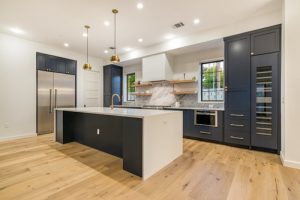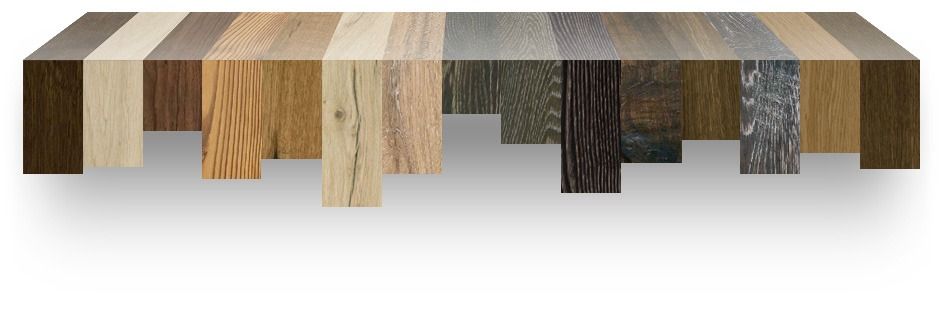
Are you seeking a modern, sleek upgrade for your home? Well, search no further! We have some perfect new hardwood flooring options for you!
Together, we’ll take a deep dive to explore the wonderful world of engineered bamboo flooring and how it can be used to enhance your home beautifully. We’ll examine the different types of bamboo flooring, the benefits this particular material possesses, and when this option might also best be avoided.
Whether you’re constructing the home of your dreams or plunging into a well-deserved renovation, we’ll demonstrate how engineered bamboo flooring can potentially raise the value of your home and create the perfect new look for you.
So, grab a notebook, and let’s get started!
What is Engineered Bamboo Flooring?
This type of bamboo flooring is best defined as a sturdy, environmental hardwood flooring option made from bamboo. It serves as a great and modern-looking selection for newer homes.
So, how are engineered bamboo floors made? They’re expertly sliced down from durable stretches of bamboo, but there are actually very few measurements of natural bamboo that go into the engineered planks. Engineered bamboo flooring also consists of a backing layer that is constructed from plywood that is cross-laminated or even made of fiberboard.
This is what makes this type of flooring so durable and enables it to last for years to come! Sounds great so far, right?
How Engineered Bamboo Flooring Can be Used
Now that we’ve looked into what this type of bamboo flooring is composed of, let’s look into how it can be used. Since it’s such a strong material, it can be used in the following ways:
· Can be installed over any subfloor that has been prepared in the proper way
· Can be fixed or floated to the subfloor
· Can be installed in rooms that are prone to higher temperatures
· Can be utilized in high traffic areas and for commercial use
· Looks great when used for furniture
Are There Different Types of Bamboo Floors?
Yes, there sure are! Taking an even deeper dive into engineered bamboo floors, let’s explore the options when it comes to different types of bamboo floors that are available in today’s market. Each one of these is formed uniquely, and so they all serve a different purpose in the home. Interested in the options at your fingertips? Let’s take a look!
Laminate Bamboo Floors
When it comes to laminate bamboo flooring, this option consists of a thin lining of bamboo that is veneered. This type of flooring is usually glued to a base or clicks together and then appears to float above a subfloor. Since the thickness of bamboo veneer can be so small, it will be nearly impossible to sand and refinish this type of flooring.
Solid Bamboo Planks
Solid bamboo floors are normally glued or nailed to the subfloor. Similar to traditional hardwood floors, they can be sanded down and then resealed.
In fact, homeowners with this type of solid bamboo flooring can reach out to a professional to better determine if your floors need to be refinished.
Strand Bamboo Planks That Are Carbonized
This unique type of bamboo flooring is normally boiled to remove any impurities or unneeded substances from the grass. Then it’s glued down and pressed in order to form solid planks. When the bamboo is carbonized, it creates a luxurious color with a beautiful amber hue. It also has the capability to soften the feeling and appearance of your wood floors.
Woven Strand Bamboo Planks
These stylish types of planks can provide numerous patterns and types of color. They are pressed down in resin, which creates unmatched durability. Woven strand bamboo flooring is also super moisture resistant, and it just happens to be one of the strongest types of flooring available in this category. When needed, it can also be refinished.
Now before we jump into the benefits of bamboo flooring, so far, which type of bamboo flooring is looking like your favorite? We always love to know your thoughts!
The Beautiful Benefits of Bamboo
Now that we know what engineered bamboo flooring entails and all of the different types offered, let’s take a look at the plethora of amazing benefits this unique flooring can yield. After all, one of these key benefits could be the key deciding factors for your home. So, take a look to see if you’ve found a perfect match!
· Top-quality bamboo is actually as durable as regular hardwood flooring.
· Bamboo flooring offers a clean, contemporary look for those who prefer modern décor.
· When the bamboo is finished properly, it can easily be cleaned with the use of a mop and mild soap.
· Bamboo flooring can be refinished when necessary. However, keep the thickness of planks in mind.
· This type of flooring is DIY-friendly. As long as it’s laminated with a top layer glued to multiple sub-layers, you’re good to go!
Potential Cons of Bamboo Flooring Options
Like all flooring types, there are a ton of strengths, but weaknesses should also be acknowledged. Take a look at the following list of potential cons bamboo flooring could bring to the table.
· Some inexpensive types of bamboo flooring could be more susceptible to slight damages such as dents or scratches.
· Bamboo does readily absorb water. Be careful if your home is located in a humidity-prone area, especially if the flooring wasn’t treated properly.
· Bamboo flooring is made to fit more of a contemporary look, so it won’t fit all décor needs.
· The flooring material itself is limited to only a few shades.
How Do I Maintain My Bamboo Floors?
With any type of flooring, some form of maintenance is needed to keep your floors looking their absolute best. You’ve got to put in the work, right? So, we’ve put together the top three tips and tricks that will have your floors looking spotless, even if it’s years down the line.
Grab your cleaning supplies and follow along!
Use Furniture Pads
While it is true that engineered bamboo flooring is durable, that doesn’t mean it’s fully indestructible. Make sure to add felt pads to the bottom of your furniture in every room. Otherwise, your favorite furniture items could end up causing a few dents, knicks, or scratches along the way.
It’s always better to be careful now than to be sorry later!
Sweep and Vacuum Regularly
Always make sure to maintain the cleanliness of your bamboo floors to obtain the best results. Routine cleaning– such as once per week – is key.
Start by vacuuming the floors, and then follow up by mopping them with a cleaner that isn’t overly strong. Make sure to avoid using wax or abrasive cleaners because they affect and dull the finish.
Check Out the Warranty
Most bamboo flooring manufacturers usually offer a warranty of 25 years on the surface finish. Some may even come with a full 30- year warranty on the finish with a lifetime warranty on the product. Now, that’s something to get excited about!
It’s best to do some research ahead of time and know what you’ll be guaranteed with a warranty ahead of time. It’s as if you’re getting a bonus thrown in, and who doesn’t like free stuff?
Our Final Thoughts
If you’re seeking to upgrade the look of your flooring, bamboo is a fantastic and modern option to select. The durability and sustainability of bamboo are unlike any other. Plus, this particular flooring option will truly add to the overall aesthetics of your home.
However, this type of flooring may not be for everyone or best suit everyone’s tastes. We realize that this type of hardwood flooring is geared toward a more specific modern aesthetic, so if that’s not what you’re looking for, then other options may be more suitable to your tastes.
Simply think about how you plan on styling or renovating your home. We’d love to know how you’re throwing bamboo flooring in the mix. After all, home renovations can be such a fun and exciting adventure. Why? Because you’re making a home out of a house, of course!
Sources:
https://www.diynetwork.com/how-to/rooms-and-spaces/floors/the-pros-and-cons-of-bamboo-flooring
https://www.angieslist.com/articles/how-much-does-bamboo-flooring-cost.htm
https://www.homedit.com/bamboo-furniture/
https://homeguides.sfgate.com/decorate-living-rooms-bamboo-floors-56936.html


